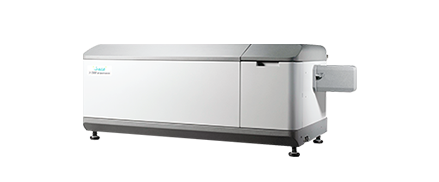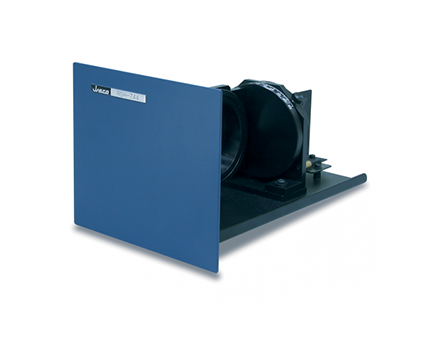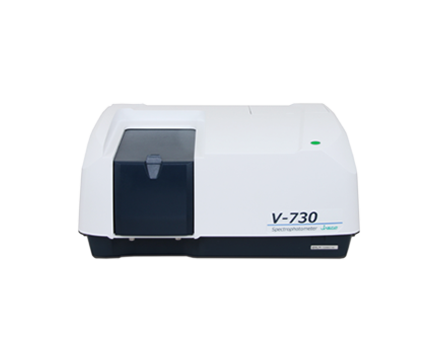Evaluation of Organic Electro-luminescent (EL) Materials
August 22, 2022
Introduction
EMV-100 Electric Field Modulation Spectrophotometer

 Molecular electronic elements that use optically functional materials, such as organic electroluminescent (EL) or organic optical conversion molecular materials are the focus of next-generation display technologies instead of LCD’s and plasma type displays. The properties of these materials can be studied using luminescence light excitation in an electrical field. Elucidating the electronic structure, molecular structure and molecular alignment of these materials after light excitation in an electric field is extremely important in the development of new materials to be used as electroluminescent elements. Techniques known to be effective for evaluating these materials are the change (AU) ∆µ in dipole moment and the change (AU) ∆α in polarizability. ∆µ and ∆α are extremely important in the elucidation of charge transfer in response to the transitions and electrical characteristics of chromophores, respectively.
Molecular electronic elements that use optically functional materials, such as organic electroluminescent (EL) or organic optical conversion molecular materials are the focus of next-generation display technologies instead of LCD’s and plasma type displays. The properties of these materials can be studied using luminescence light excitation in an electrical field. Elucidating the electronic structure, molecular structure and molecular alignment of these materials after light excitation in an electric field is extremely important in the development of new materials to be used as electroluminescent elements. Techniques known to be effective for evaluating these materials are the change (AU) ∆µ in dipole moment and the change (AU) ∆α in polarizability. ∆µ and ∆α are extremely important in the elucidation of charge transfer in response to the transitions and electrical characteristics of chromophores, respectively.
 The EMV-100 Electric Field Absorption Spectra Measurement System can be used to measure the change in absorbance of a sample in the region from the UV to NIR in the presence of an applied electric field, with quantification of ∆µ and ∆α (the characteristic parameters of absorption and fluorescence transitions).
The EMV-100 Electric Field Absorption Spectra Measurement System can be used to measure the change in absorbance of a sample in the region from the UV to NIR in the presence of an applied electric field, with quantification of ∆µ and ∆α (the characteristic parameters of absorption and fluorescence transitions).
Pyrene doped on a PMMA (polymethylmethacrylate)

As examples of the characteristic spectra indicating the Stark shift, the figure above shows an absorption spectrum, first derivative of the absorption spectrum and an electrical field absorption spectrum of a pyrene-doped polymethylmethacrylate film. The electric field absorption spectrum has the same waveform as the first derivative of the absorption spectrum and the change in absorption intensity by the electric field suggests that it is due to a change in the molecular polarizability.
Featured Products:
-
Film Holders for UV-Visible/NIR Spectrophotometers
-

Highest performance with a wide range of accessories for maximum flexibility to meet complex research demands.
J-1500
-
V-730 UV-Visible Spectrophotometer

Evaluation of Organic Electro-luminescent (EL) Materials
Introduction
EMV-100 Electric Field Modulation Spectrophotometer

 Molecular electronic elements that use optically functional materials, such as organic electroluminescent (EL) or organic optical conversion molecular materials are the focus of next-generation display technologies instead of LCD’s and plasma type displays. The properties of these materials can be studied using luminescence light excitation in an electrical field. Elucidating the electronic structure, molecular structure and molecular alignment of these materials after light excitation in an electric field is extremely important in the development of new materials to be used as electroluminescent elements. Techniques known to be effective for evaluating these materials are the change (AU) ∆µ in dipole moment and the change (AU) ∆α in polarizability. ∆µ and ∆α are extremely important in the elucidation of charge transfer in response to the transitions and electrical characteristics of chromophores, respectively.
Molecular electronic elements that use optically functional materials, such as organic electroluminescent (EL) or organic optical conversion molecular materials are the focus of next-generation display technologies instead of LCD’s and plasma type displays. The properties of these materials can be studied using luminescence light excitation in an electrical field. Elucidating the electronic structure, molecular structure and molecular alignment of these materials after light excitation in an electric field is extremely important in the development of new materials to be used as electroluminescent elements. Techniques known to be effective for evaluating these materials are the change (AU) ∆µ in dipole moment and the change (AU) ∆α in polarizability. ∆µ and ∆α are extremely important in the elucidation of charge transfer in response to the transitions and electrical characteristics of chromophores, respectively.
 The EMV-100 Electric Field Absorption Spectra Measurement System can be used to measure the change in absorbance of a sample in the region from the UV to NIR in the presence of an applied electric field, with quantification of ∆µ and ∆α (the characteristic parameters of absorption and fluorescence transitions).
The EMV-100 Electric Field Absorption Spectra Measurement System can be used to measure the change in absorbance of a sample in the region from the UV to NIR in the presence of an applied electric field, with quantification of ∆µ and ∆α (the characteristic parameters of absorption and fluorescence transitions).
Pyrene doped on a PMMA (polymethylmethacrylate)

As examples of the characteristic spectra indicating the Stark shift, the figure above shows an absorption spectrum, first derivative of the absorption spectrum and an electrical field absorption spectrum of a pyrene-doped polymethylmethacrylate film. The electric field absorption spectrum has the same waveform as the first derivative of the absorption spectrum and the change in absorption intensity by the electric field suggests that it is due to a change in the molecular polarizability.

 Download This Application
Download This Application
